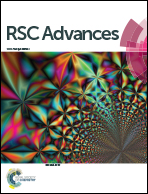Water-responsive dual-coloured photonic polymer coatings based on cholesteric liquid crystals†
Abstract
This work describes a straightforward method to prepare patterned photonic coatings which alter their colour when exposed to water. Various kinds of dual-coloured patterns were made, which become visible or fade away when placed in water. These effects are reversible and can be repeated many times.


 Please wait while we load your content...
Please wait while we load your content...